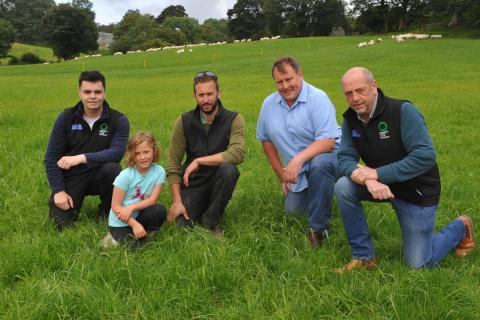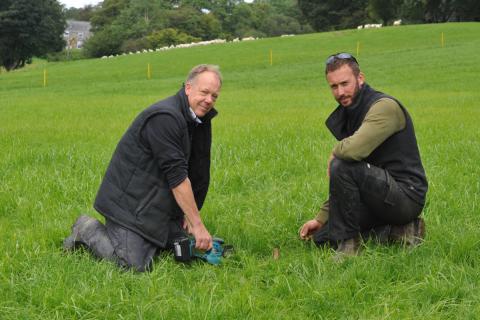29 August 2019
Geraint and Rachel Davies took over the family farm at Fedw Arian Uchaf, Bala, in 2011 but, because there had been no reseeding or nutrient management programme for over 20 years, grass production was poor.
A Nutrient Management Plan part funded by Farming Connect revealed that no field on the organic holding had a pH higher than 5.8 and potash and phosphorous levels were mostly at index 0 or 1.
To address those shortfalls, Mr and Mrs Davies applied 1,000 tonnes of lime over an eight-year period and this programme is ongoing.
They have also refurbished existing farm tracks to help facilitate the application of farmyard manure to fields.
They then set about reseeding 61 hectares (ha) of their 81ha of grassland with varieties that matched their system and climate and their desire to grow more feed in the spring and autumn to shorten the housing periods for their flock of 650 Welsh Mountain ewes and 50 suckler cows.
During a recent Farming Connect open day at the farm, independent grassland expert Chris Duller, who has been involved in the reseeding project, said that an around £500/ha reseeding costs were not insubstantial but pointed out: “If you can grow an additional three tonnes a hectare and utilise that grass you will recover the cost in the first year.’’
In a beef system, every additional tonne of dry matter that is utilised by cattle can be converted into around £185 worth of liveweight gain.
“Many old leys are likely to be producing less than 7tDM/ha each year but a new long term ley should easily produce 10t in its first year, a short-term ley even more,’’ said Mr Duller.
As well as Italian ryegrass leys, which have the potential to grow 17-18tDM/ha in the first year, the Davies’ are also growing Westerwold, an annual ryegrass, which will provide grazing through late autumn and in early spring the following year as well as growing an early silage crop.
Mr Duller said short-term leys are not only a good for cleaning up fields with weeds but they fill the grass growth curve. “Having a range of sward types and some forage crops gets away from the boom and bust where everything is growing flat out in June and July but there isn’t enough at other times,’’ he said.
A downside, particularly for organic systems like the one at Fedw Arian Uchaf, is that short-term leys have a high nutrient demand. They can also be prone to diseases such as crown rust and produce an open sward which can cause issue when grazing in wet conditions.
Utilisation can also be challenging, particularly with a Westerwold, as it can soon start to produce seed heads if there is insufficient grazing pressure.
Twelve weeks after sowing, the Westerwolds and Italian leys at Fedw Arian Uchaf provided a light silage cut – yielding 2.7 and 2.3tDM/ha respectively.
Eighteen days later and lambs were on the very well grown aftermaths
Mr and Mrs Davies are also growing forage rape and swedes in a bid to eliminate concentrate inputs.
Mr Duller said a drawback of growing fodder crops is that it results in bare fields in the spring but he advised that this could be offset by growing a companion crop of Italian ryegrass. “If you are growing five acres of swedes, grow five acres of Italian in another field so that livestock have feed to transition to.’’
Another issue Mr and Mrs Davies are addressing is water management. Despite the farm’s exceptionally high level of rainfall, the natural water sources for livestock can run dry quickly and this impacts on the rotational grazing system.
Through Farming Connect, the couple have embarked on a Water Management Plan and are now considering the options of drilling a borehole or creating ponds.
They are also addressing the provision of shelterbelts for livestock through hedgerow and woodland management and are working with Coed Cymru and the Snowdonia National Park Authority on a project to manage a 35-acre ancient oak woodland.
Geraint Jones, Technical Officer for Forestry at Farming Connect, said it is important that farmers don’t ignore their green infrastructure as by optimising the benefits of hedges and woodland they can improve economic and environmental performance.
“These are assets which can be taken for granted or forgotten about but are an important means of reducing carbon emissions and improving livestock health and welfare through shelter provision,’’ said Mr Jones.
TIPS FOR MAKING BETTER USE OF HEDGEROWS
Take a whole farm approach to deciding which hedges to manage with a hedgerow management plan.
Gaps at the bottom of hedgerows create a wind tunnel effect so consider hedge laying. Course are available through LANTRA.
If creating paddocks, ensure there is sufficient shelter – hedges should be of appropriate length and scale to provide as much shelter as possible for the number and class of livestock allocated to each paddock.
Identify a funding stream to help meet the cost of improvements.
When designing and planting a shelterbelt or hedgerow, select a proportion of species that will provide height to maximise the reach of shelter into a field.
Farming Connect, which is delivered by Menter a Busnes and Lantra, is funded by the European Agricultural Fund for Rural Development and Welsh Government.


